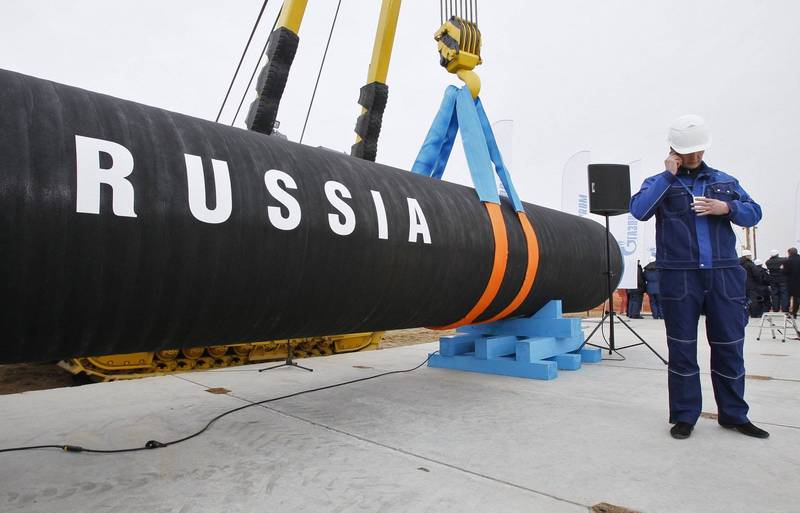Russia's Nord Stream 1 submarine gas pipeline to Germany has been reported to have ruptured and leaked.
The picture shows the Beixi natural gas pipeline under construction on April 9, 2010.
(Associated Press file photo)
[Central News Agency] Gas leaks occurred on the Nord Stream 1 and Nord Stream 2 pipelines in the Baltic Sea that transport Russian natural gas to Germany on the 26th. Politicians in Europe and the United States immediately blamed the problem on Russian sabotage, but foreign media analysis pointed out that there is currently no evidence. Difficult to determine where.
●The leakage of Beixi pipeline points to man-made sabotage
Deutsche Welle reported that the Danish Energy Agency pointed out that there were two leaks in the Nord Stream 1 pipeline in the northeast of Bornholm, and Nord Stream 2 (Nord Stream 2) There were also two leaks in Swedish waters southeast of the island.
Please read on...
"These are not small cracks, they are big holes," the Danish Energy Agency said. European Commission President Ursula Von der Leyen called it "sabotage" and U.S. Secretary of State Blinken said. Antony Blinken) expressed the same view.
Polish Prime Minister Mateusz Morawiecki said the gas leak "may represent the next evolution in the deterioration of the situation in Ukraine".
●The cause of the rupture of the Beixi pipeline points to an explosive device
The Danish authorities said in a statement: "Breaking of gas pipelines is extremely rare." Nord Stream 1 and Nord Stream 2 are laid 70 to 90 meters below sea level. The pipelines are made of steel with a wall thickness of 4.1 centimeters. Covered with 11 cm thick reinforced concrete.
The New York Times reported that the Nord Stream pipeline could therefore withstand underwater pressure, in other words, it would take a lot of power to break the pipeline.
Kristoffer Bottzauw, head of the Danish Energy Agency, said leaks of this nature were extremely rare and "it is unlikely that three leaks would occur in a 24-hour period".
Hans Liwang, a professor at the Royal Institute of Technology in Sweden, said that by examining the size of the crater and the degree of damage to the pipeline, the amount of explosives and the location of the explosion can be known.
"By looking at the traces at the bottom, we might be able to determine where the explosive device was placed," Riwan told the Svenska Dagbladet (Swedish daily).
He also said the leaking gas could wash away vital evidence, especially if, as some have speculated, the sabotage was carried out using unmanned underwater equipment or by divers.
●All walks of life accuse Russia of what it did but there is no evidence to support it
"I think this is just the beginning," said Sebastian Zukowski, a resident of Poland's Warminsko-Mazury province, which borders the Russian enclave of Kaliningrad. Vladimir Putin will take Ukraine next year and then look to the West, including Poland and Finland.”
Several experts have also blamed Russia for the leak, but so far no one has been able to provide evidence, or perhaps none at all.
"Based on all the evidence, of course there is a suspicion of sabotage, most analyses point to Russian sabotage," said Anna Mikulska, an energy expert at Rice University.
One of Russia's possible motives is to create chaos, Grzegorz Poznanski, secretary-general of the permanent secretariat of the Council of Baltic States (CBSS), told DW: "This could of course be another tactic of Russian hybrid warfare. ” Mikuska agrees.
"It certainly looks suspicious, but nothing Russia has done surprises us," said Joanna Przedrzymirska, deputy director of the Institute of Oceanography at the Polish Academy of Sciences.
Leaks could push up energy prices to benefit Russia
The New York Times analysis pointed out that in some respects, the destruction of the pipeline has no direct meaning for any party, and it is not clear why the Moscow authorities want to destroy the multi-billion-dollar construction and maintenance of Gazprom. pipeline facilities.
But the gas market was spooked, helping Russia to raise gas prices.
On September 26, European gas futures prices were nearly halved from their August highs, but after news of the leak, prices rose nearly 20 percent to around 205 euros per megawatt-hour, about 5 percent a year earlier. times.
● what the United States or Ukraine did?
Arnold Dupuy, head of the NATO Science and Technology Organization, believes that the person who sabotaged the pipeline may also be an anti-Kremlin group in Ukraine.
In addition, Radoslaw Sikorski, a Polish member of the European Parliament (European Parliament), suggested that the party deliberately sabotaging the gas pipeline may be the United States, tweeting "Thank you, United States", the tweet attached A photo of the Baltic Sea.
●The environmental impact of a large leakage of natural gas is worrying
The New York Times reported that the damaged Nord Stream pipeline was spewing out natural gas, mainly methane, the main cause of global warming.
The head of the Danish Energy Agency, Portsau, said that as of September 28, more than half of the fuel in the Nord Stream pipeline had leaked, and it may be completely drained by October 2.
Portsau also mentioned that the damage caused by the leak could be equivalent to 32% of Denmark's annual emissions, "which has a significant impact on the climate, because methane is many times more damaging to the climate than carbon dioxide."
Scientists hope that the gases that are rushing to the surface and spreading into the atmosphere won't have a major impact on the flora and fauna of nearby waters.
The Nord Stream No. 1 natural gas pipeline on the seabed of the Baltic Sea has ruptured in many places, and a large amount of natural gas has been leaked; the picture is provided by the Swedish Coast Guard (Swedish Coast Guard; Kustbevakningen). Huge bubbles of natural gas leaked from Xi No. 1 kept gushing out of the water.
(AFP)
